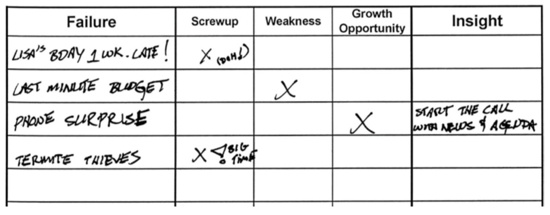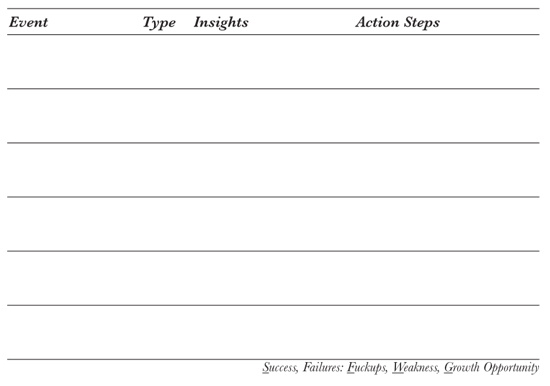That some good can be derived from every event is a better proposition than that everything happens for the best, which it assuredly does not.
James K. Feibleman
The book «Designing Your Life» by Burnett and Evans had a few interesting suggestions for creating a meaningful life. One tip was to use a reflection table in order to learn from the past week and improve in the future.
In the book, the table looked like this:

The failures are written down and then classified whether they are
- Screwups: Simple mistakes, you normally do it right, nothing to learn here, just acknowledge it, apologize if needed, and move on.
- Weaknesses: Mistakes you repeatedly make, some might be changeable, but usually best to avoid getting in such a situation.
- Growth Opportunities: Mistakes you can avoid in the future if you learn from them.
There is also the insight table to find solutions, e.g., action steps you can take to avoid these mistakes. Although going by the classification in the book, it only makes sense for Growth Opportunities.
Personally, I think the table is pretty useful. I tried it out during the last few weeks and it works very well. However, I would suggest a few changes:

I would focus on «critical incidents» or «events» (shorter) that can be both a success or a failure. After all, it is not only the failures you can learn from, also the (at times unexpected) successes. The inclusion of «success» requires the renaming of «Screwups» to «Fuckups». It is more honest and you can use «S» and «F» in the Type column, which replaces the three — now four — separate columns for the type. I think «Insights» are important, but I would also add a dedicated «Action Steps» column. After all, insights without actions are impotent.
The resulting table can be used to reflect on the week, identify the critical incidents (if you have not already jotted them down at the end of the day) and reflect on them. Afterwards you «only» have to implement the action steps. Oftentimes this means using another tool to remind myself what (not) to do and when.
Of course, the table can also be used for longer time frames, e.g., one’s (work) life. Major incidents should still shine (uncomfortably) bright in one’s memory.
Happy reflecting.
Reference: Burnett, W., & Evans, D. J. (2016). Designing Your Life. How to build a well-lived, joyful life. Alfred A. Knopf.